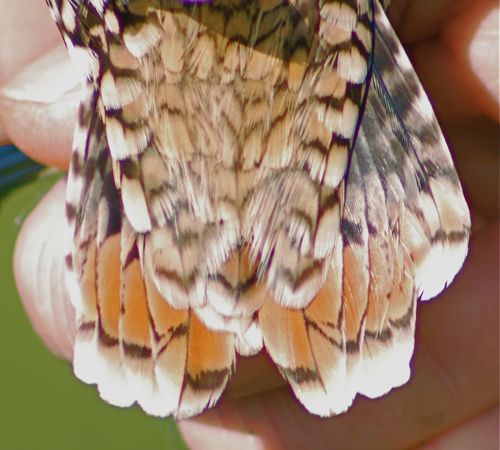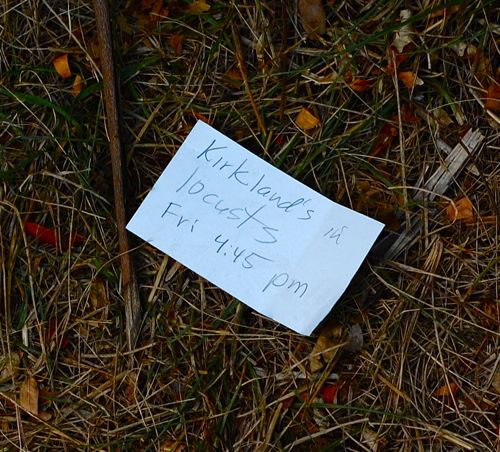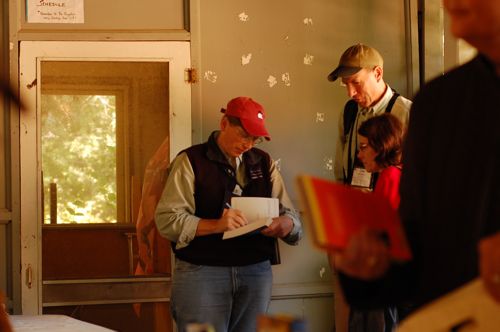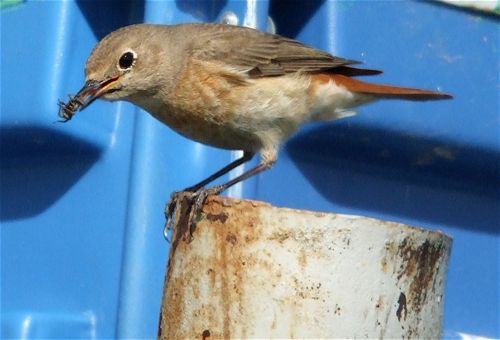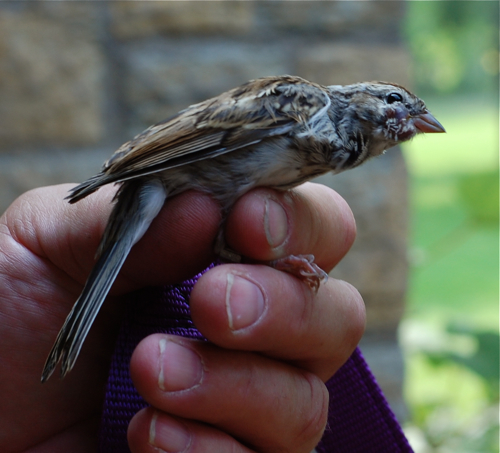Random Trumpeter Swan
Oh man am I missing hawk banding this fall! I just felt a pang on Saturday and now after reading my buddy Amber's blog about a very cool peregrine recapture, I'm ready to sit in a dark box nestled on the edge of the northern woods facing a fallow farm field and Lake Superior and seeing my hawking buddies. Last night as Non Birding Bill and I were headed out to dinner to re-establish our pair bond (a tradition for when either of us comes home from a trip out of town), we passed the Buzza Building on Lake Street in Uptown and noticed a peregrine perched on top--raptor migration is hot and heavy!
I'm still sorting through all of my shorebird photos from the Midwest Birding Symposium and also have quite a few trumpeter swan photos. Which reminds me, I start a project next week for work that both excites and terrifies me. I'm going to count waterfowl along the upper Mississippi River this fall...from a small plane swooping overhead. I have issues with flying (yeah, I know, I fly a lot). On big planes, I fall right to sleep during take off, now matter how much coffee or espresso I have before I board. Once the plane is airborne, I'm fine. I'm even fine during landing, it's take off that seems to do it...and helicopters where the front windshield is a bubble and when you look down at your feet, you see the ground far below you.
I think I'm going to be fine in this small plane. I think my issues with big planes is a feeling of a lack of control and not being able to watch the pilot's actions to make sure I know what they are up to. But I have never been one to let fear block a cool opportunity. So, I will count ducks and hopefully conquer my fear of flying this fall as I count ducks on Mondays.
And, can I say a big thank you to eBird for the articles here and here on tips for counting large flocks of birds. It's been very handy, as have my flash cards of duck backs.
Holy Crap, Heron vs Big Ass Fish
Zeiss rep Steven Ingraham posted this video he got with his scope and video camera combo of a great blue heron working a great big fish: [youtube]http://www.youtube.com/watch?v=_m4PWn8yFO8[/youtube]
Midwest Birding Symposium Highlights
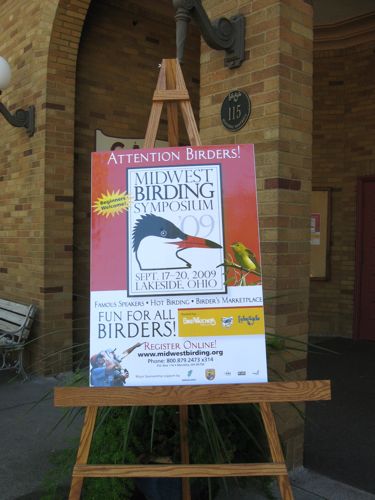 I'm just back from the 2009 Midwest Birding Symposium and this was the most insanely busy birding event I have ever been to. There was so much going on and so many people, my only complaint was that I didn't have the time to have an actual conversation with many people from people I want to meet to old friends I rarely see in person.
I'm just back from the 2009 Midwest Birding Symposium and this was the most insanely busy birding event I have ever been to. There was so much going on and so many people, my only complaint was that I didn't have the time to have an actual conversation with many people from people I want to meet to old friends I rarely see in person.
The symposium was held in a gated/resort community in northern Ohio, right on Lake Erie (and had a large feral cat population). It's a small "dry" town with cute houses fitted close together owned by wealthy people--I learned that the cottage I was in is owned by the Windex family so I was blessed with bright shiny windows. But you could walk/bike all over and it was interesting to walk from the cottage I was staying in to the speaker and vendor areas and pass birder after birder--many well known ones. "Oh, hey, there's Kenn Kaufman. And over there is Scott Weidensaul and over there is Sibley." The small community had totally turned into Birderville: population 1000. I have to say, that Minnesota birder and one of the best speakers on the bird festival circuit, Al Batt, brought down the house with his keynote. All the speakers were great, but Al as usual stood out and left people sore with laughter the next day--way to represent the Minnesota team, Al! Speaking of speakers, Jim McCormac has a blog post up and if you scroll down, you can watch a video of Kenn Kaufman behaving like a horny mourning dove (so much for Lakeside being a dry community).
I didn't take the above photo of ring-billed gulls. I lovely woman I met named Marilyn took it with my digiscoping set up. Part of my duties at the symposium was helping out at the Swarovski booth and help people with digiscoping. Even in early morning with low light, she was able to get a great shot with my HD 80 scope, Nikon D40 and DCA digital adaptor. I did enjoy working one on one with people to help them hone their technique...and explaining how to use Twitter.
The event was more about information and workshops than it was about birding but there was quite a bit going on. The bird of the festival was a Kirtland's warbler that was spotted five minutes from the event and many were able to go out and get photos of this accommodating life bird. Here's one over at 10,000 Birds. I went to look for it late in the day on Friday and had to chuckle at all the birder litter guiding folks to the spot where it could be seen. I did not see it, but I wasn't trying all that hard either (as can be seen in this blog entry over at Born Again Bird Watcher. Although, while a I was laying on the ground avoiding warbler neck, a Cooper's hawk flew low over the group and I had the best view. I joked that it appeared to have a warbler shaped crop and that was the reason we weren't seeing it. I left early, I think a Kirtland's is one of those rare birds that I know I'll see one day, I'd like to make it to Michigan. I actually spent more time watching shorebirds at the symposium--more on that later.
I had a total geek out moment. I was included in the book signing area for City Birds/Country Birds and it was an honor to be surrounded by the likes of Julie Zickefoose and Scott Weidensaul (above), but the real excitement for me was getting to sit next to Lang Elliot! He's written several great books, but many people out there know his voice. If you have any birding cds, chances are good that you have heard his classic, subdued voice narrating the species' names. I listened to these eight hours a day, five days a week when I worked at the bird store (eight years). I have to say, he may sound scientific and stuffy based on the narration, but he's hilarious. I told him that I had heard his voice so long saying bird names, I had always wanted to hear him swear. So, he swore at me. Loved it! Love meeting these hardcore dedicated scientific types and learning that they've got a little freak flag in there and they're not afraid to wave it.
Congratulations to Bird Watcher's Digest and all of their hard working staff who made the event so well attended and so action-packed with great content!
I'm Showing People How To Blog
Mike Bergin and I are here at the Midwest Birding Symposium showing people how to blog and use Twitter or heck, just answer Internet questions. Here is a photo I'm using as a demo:

This this a snipe from the shorebird banding workshop. Isn't this a dynamite look at this sneaky little shorebird? How can you say that they do not exist and how can people create such a weird snipe hunting prank with this dude. More on him later. Here's an example of a video that you can upload:
[youtube]http://www.youtube.com/watch?v=fj5gDN6akG0[/youtube]
We are using this video of great hummingbird action from my trip to Guatemala last February because Operador Latino is in the booth next to us and this is just a taste of the fantastic birds that you can see in Antigua.
Here's a redstart from our trip to Kazakhstan and I'm posting it to show that someone who has never used their new UCA Adaptor with their scope and point and shoot camera can get a reasonably good photo after using it for just an hour. I remember how bitter I was to be on the trip of a lifetime and forced to use a new camera adapter to take photos and then figured it out relatively quickly. This is good because many point and shoot digital and video cameras can work with this universal adaptor.
Where Bad Bird Info Started
Non Birding Bill sent me a link to a silent film that kind of explains where that urban legend comes from, the one where someone comes up to you and asks, "I heard that the (insert your state here) DNR is paying off a family. Apparently, a bald eagle swooped down and took off with their four month old baby. The DNR conducted a search and later found the baby's shirt (or diaper or pants or hat or sweater) in the nest. The DNR is now paying the family millions of dollars to keep quiet so the general public won't go out and randomly shoot bald eagles. Is this true?" No. Number 1: the DNR doesn't have that kind of money. Number 2: No family could be paid enough to keep something like that happening to their baby quiet. Number 3: Bald eagles weigh on average 10 - 12 pounds and can only carry half their weight in flight. How much does a four month old weigh? Too much! And yes, I did see the story about the New Zealand "man" eating eagle.
Laugh, but I do get this question...a lot. Almost as much as I get the question, "Is it true that hummingbirds fly on the backs of Canadian geese during migration?"
No. Number 1: It's Canada geese. Number 2: Ruby-throats can and do cross the Gulf of Mexico on their own two wings.
But, good old NBB found this lovely silent movie demonstrating the legend of an eagle carrying off a baby. Enjoy:
[youtube]http://www.youtube.com/watch?v=1lflJ6ZVKgo[/youtube]
Roadrunner Attacking Cowbird Video
I love birding--you can do it anywhere and I love to show people that. To prove it, I called some friends: WildBird on the Fly and Clay Taylor and said, "Let's make some videos on birding and digiscoping in Las Vegas. We are probably going to have at least 4 when Non Birding Bill is finished editing them (and one with a very exciting guest!). So, here is one of them, this was done at Spring Mountain Ranch State Park and features the video footage of the roadrunner nailing the cowbird: [youtube]http://www.youtube.com/watch?v=4Mv2RNJDZqk[/youtube]
I'd like to thank Swarovski Optik for making these videos possible. This was all filmed with your basic digital cameras from point and shoot, to handheld video to digital SLRs and Swarovski spotting scopes.
Don't forget, I have a digiscoping contest going on, where you could win some great Swarovski binoculars!
Tibetan Sky Burials
WARNING! I'M POSTING A VERY GRAPHIC LINK. IF YOU HAVE A WEAK STOMACH OR ARE REMOTELY SQUEAMISH, DO NOT CLICK. SECOND WARNING! The first link I posted has graphic pornography ads on the same page as the vulture images. I had no idea because my ad blocking software completely blocked it when I checked the link. I posted a second link with no naughty ads at the end. I hope no one got in trouble at work for checking that link.
Edit to add: There are also ads for "adult" sites on the page. Our apologies.
If you have a strong stomach and want to see the "greenest" funeral possible, then check out this photo series of a Tibetan Sky Burial. With a lack of trees for a funeral pyre and a hard, rocky soil not easy for burial, they use what they have . Honestly, this is how I would love to be disposed of, but Non Birding Bill understandable refuses to help with such an endeavor.
Here is a link to the series of photos, without the naughty ads.
Banding Wilson's Warbler & Chipping Sparrow Tumor
WARNING! THERE ARE SOME KIND OF GROSS BIRD TUMOR PHOTOS IN THIS POST. Don't worry, I'll end on a nice cleansing post.

The colors at Carpenter Nature Center are outstanding right now. This amazing palette will last over the next month or so, so if you need a day to just look at some beautiful late summer flowers, this is the place to be.
Many of the birds in the nets for Friday's banding were pretty too, like this Wilson's warbler. I wonder if this bird is on his way to Guatemala? It was the most common warbler I remember seeing there last February. Between the ones I see around MN, Las Vegas, and Guatemala, I think this is the most common warbler I have seen all 2009, I think I have seen more of these than I have yellow-rumped warblers.
Here's an above view of that Wilson's warbler, a hatch year male. His cap is growing in well and his outer tail feathers are pointed. McGill Bird Observatory has a good website with photos showing how they age and sex birds in the hand (certainly is easier to read than Pyle).
Hey! For some crazy shots of a "washed out Wilson's warbler" found during banding, check out Bill Schmoker's blogWil.
Some days when we band birds, it is fairly easy to get them out of the nets, other days it seems as though every bird gets tangled up in some weird way, how will I ever get them out. This was one of those days. However, get them out we did. We did see two birds that appeared to be having some health issues.
One bird was a field sparrow. I did not get photos of it, but as I took it out of the net, I could see that its head was missing several feathers, almost like a bald cardinal. Not only that, the exposed skin looked dry and had what looked like sore patches. The bird also had a bit of bleeding around the neck. As soon as it was out, it was let go. This was not a situation where the bird could have been taken to a rehab center and there was no point in furthering any stress. Whatever this poor field sparrow had going, banding was not going to help. I had to make sure to wash thoroughly with anti-bacterial soap, so as not to risk spreading whatever the bird had.
We also had a chipping sparrow fly in to the nets with a tumor.
Apart from the tumor, this bird appeared healthy. The lump looked like it might be a blister, but the tumor was rock solid.
If you look at it from the front, it appears as though it starts right at the gape. It's hard when these come in. As a human, you would like to do something to help, to make a bird's life easier. However, would wildlife rehab really help a bird like this? Would it be better to let it live out what life it has in the wild than to have spend a few days terrified in a clinic where it most likely will be put down? Birds with illnesses and injuries are eaten by predators, it's a valuable source of food for migrating hawks, wouldn't it be better to let that be the ultimate end, where it continues to the cycle of life, rather than die quietly indoors? And we certainly were seeing hawks passover--especially sharp-shinned hawks.
It's never an easy call, but something that banders are faced with from time to time.
I end with a photo of goldenrod surrounded by some of the other flowers and leaves. If you are looking for a place to visit with some great color, Carpenter is it at least for the next month.
What's On The Mourning Dove's Mind?
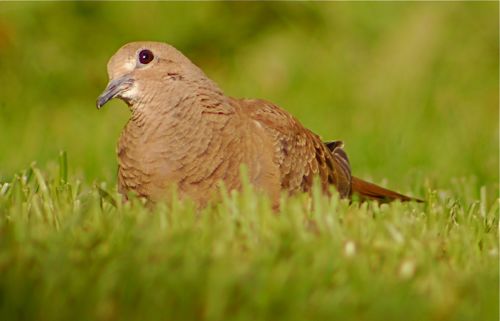 You know what this mourning dove pondering with its chickpea like brain that governs its large body? That the world is crazy!
You know what this mourning dove pondering with its chickpea like brain that governs its large body? That the world is crazy!
I have never been comfortable when people tell me that they think some birds are "evil." I don't think you can categorize species as good and evil and that if you look at any species long enough, every bird has a dark side. Many people don't like crows because they eat other birds' eggs and nestlings, but many birds do that including woodpeckers and herons. Well, to further prove that if you study a species long enough that you'll find a "dark side" researchers have discovered great tits (a cousin of the chickadee) eating hibernating bats! What did I just type (let me read that again), yup, tits eat bats, that's what a wrote.
It's not something they do all the time, they prefer seeds and bugs but when the forage gets tough and the winter is long, they will take advantage of a hibernating bat as a source of food. Makes you want to keep a good eye on those chickadees doesn't it? Read the full story and see the video here.
The other thing this mourning dove might be pondering is diversity in the outdoor community. It's been a hot button issue with me this week and there are a few conferences coming up on how we can get people of all cultures involved in birding and the outdoors. I have asked if there is a vibe being put out to keep other cultures away from birding and this story from The Wonk Room suggests that might be the case:
Based on the recent discovery of marijuana farms on public lands, the U.S. Forest Service in Colorado said it suspected an international cartel was behind the state’s hidden weed farms. Officials issued a warning that asked visitors to look for signs of drug trafficking. The signs they suggested visitors look for? Oh, just telltale signs like campers eating tortillas, Spam and canned tuna, people drinking from Tecate beer cans, or Latino music and people speaking Spanish--all of these could be signs of illegal dope dealers and that if you encounter this, hike away immediately and call police.
Are you kidding me? No one caught that press release before it went out? They have since retracted it, but it's that kind of thinking that makes the outdoors seem like something only white people can do properly and that's just wrong. Geez, spam and tinned tuna are kind of a camping tradition for many people, not just Latinos (why in Minnesota, it's practically in the state charter that you bring it camping. Tortillas are also a staple with me (and a non Latino friend who has a yeast allergy), but fortunately I speak French and not Spanish, have Depeche Mode and bird calls in my iPod, and tend to favor scotch and gin over beer.
And yes, this is a real story, it even made it to MSNBC.
Well, let's wrap this up on a cuter note:
Some students in Florida want to change the state bird from mockingbird to osprey. Tired of having a bird that is also used by Arkansas, Mississippi, Tennessee and Texas, the state wildlife commission asked schoolchildren to pick a new state bird. More than 20,000 voted for the osprey.
The osprey "represents the thousands of miles of river ways, lake shores and coastlines that make Florida distinctive in the United States and where this regal bird makes its home," the staff of the Florida Fish and Wildlife Conservation Commission wrote in a memo last month.
Yet, there is a challenge. Apparently a lobbyist with the National Rifle Association named Marion Hammer has thwarted attempts to change the state bird in the past and is prepared to lobby again.
"I remain unequivocally opposed to changing the state bird," Hammer has said.
She makes it clear that it's not an NRA policy but that she just loves mockingbirds.
I'm in favor of a state lobbying for a bird that is not used by other states and the fact that it is a raptor is a bonus in my book. However, if there is a state that needs to change its state bird, it's Rhode Island, seriously, what's up with the chicken representing that state?

